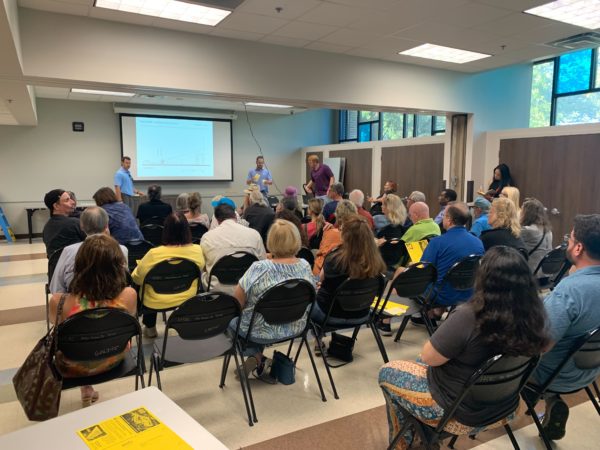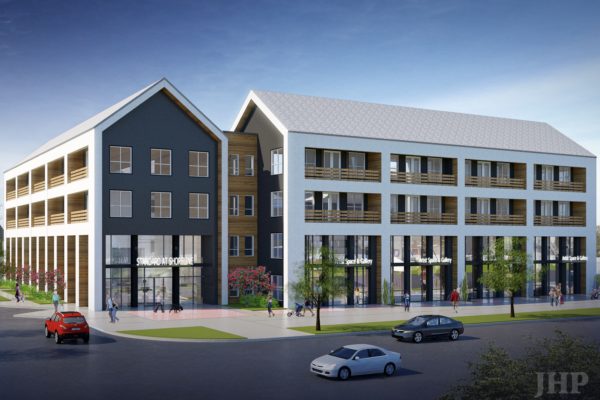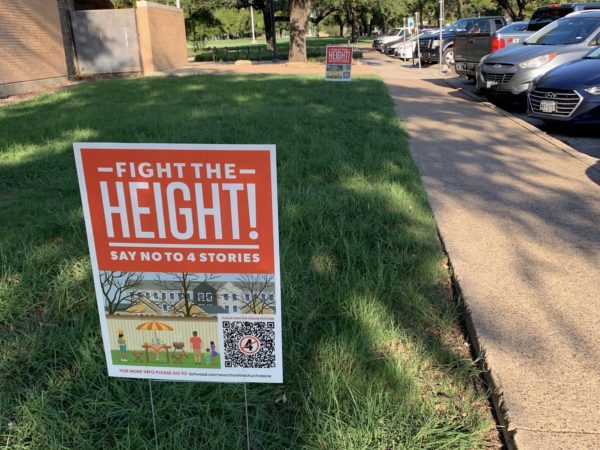
Neighbors attend a meeting held Sept. 8 at Harry Stone Recreation Center to discuss the Shoreline Standard development. Photo by Sam Gillespie.
The developer of the proposed mixed-use Standard Shoreline project hosted what looks to be the last neighborhood meeting before the City Plan Commission hearing, and after a presentation of the plans and Q&A session, neighborhood skeptics remain.
About 65 people, including Michael Jung, the Plan Commissioner for District 9 where the site is located, attended the Sept. 8 meeting at Harry Stone Recreational Center. District 9 City Council member Paula Blackmon was not in attendance.
The first neighborhood meeting on April 12 was hosted by the Lochwood Neighborhood Association. Time was granted to Ojala and Lochwood leadership to present their case for and against. The presentations were followed by a Q&A session that, according to some standards, fell short of an adult discussion on the issues of density, affordability, traffic, building height, flood control, school populations and municipal tax policy.
Ojala set the agenda for Thursday’s meeting: 30 minutes for an Ojala presentation and 30 minutes of Q&A, with questions submitted in writing on Ojala-provided note pads. Many in the audience squirmed under those guidelines, some shouting about being “treated like children.” The format gave Ojala a chance to address as many issues as possible without some people making statements rather than questions, rambling about unrelated issues or resorting to name–calling. On the other hand, the “hand your written questions to us” rule does not allow for any follow-ups, clarification, healthy debate or disagreement, if there is such a thing on an East Dallas zoning case.
The current zoning of the property is single-family residential R-7.5A. The church has been the location of several congregations since Garland Road Church of Christ built the building in 1955. It’s now home to the non-denominational Shoreline Church, which is under contract to sell the property to Ojala with intentions to move to the current location of Highland Oaks Church of Christ near the intersection of Walnut Hill and Plano Road. The sale to Ojala is contingent on a successful rezone of the property by the developer to Planned Development District (PD).
Daniel Smith, managing director of Ojala Holdings, opened the meeting and took 20 minutes to review the evolution of the project, noting many design changes from the original PD submittal. These include a decrease in the number of units (to 300 from 310) and building height (to 60 feet from 66 feet). Smith noted the addition of a public art park, below-ground utilities, electric vehicle parking and a 9-foot privacy fence adjacent to child care provider Modern Tot to the north and the houses on Yorkmont Circle to the south. Ojala is also proposing a Good Neighbor Agreement, which allows adjacent property owners to review lighting, landscaping and construction logistic plans. While no change from the original February 2022 PD submittal, Smith emphasized the 3,000 square feet of creative office space, the large detention area and open space for a dog park and playground.

Standard Shoreline. Rendering courtesy of Ojala Holdings.
Smith detailed aerial photographs and drone footage (shown here) of the view south toward the homes on Yorkmont Circle. Using a cross-section, he showed how a 6-foot person standing in the backyard of one of the affected Yorkmont Circle homes could not see the four-story project due to trees and the two-story townhomes proposed on the southern boundary.
Smith wrapped up with a review of the affordable, attainable aspects of the project. He emphasized that Standard Shoreline is not a Section 8 voucher project but a development participating in a new City of Dallas program (administered by an agency called the Dallas Public Facility Corporation) that provides tax benefits to new construction if the developer sets aside 50% of the units for residents who earn no more than 80% of the AMI for that area. Smith says that threshold captures “working-class” residents who, depending on family size, make $50,000-$70,000 annually and would get a $200-$500 discount off of market rents.
The details are complex, but essentially the City of Dallas takes title to the land (not the building), earns a fee at closing, signs a 75-year land lease with the developer, receives monthly land lease payments, gets a portion of the proceeds if the project sells and takes title to the building after 75 years assuming the lease isn’t extended.
If anything, opposition to the project, centered in Lochwood, is organized. Signs with a bright red background with white letters shouting “Fight the Height” peppered the sidewalks leading to the meeting location. Neighborhood leadership, including Scott Robson and Thomas Buck, were greeting attendees and handing out professionally designed flyers with perforated postcards pre-addressed to Council member Paula Blackmon and her Plan Commission appointee, Michael Jung, voicing opposition to Standard Shoreline. A QR code on the same flyer led to an online petition against the project. Many onlookers sported stickers with a 4 (meaning four stories) in a circle with a line through it.

Signs opposing the proposed rezone of Shoreline Church of Christ were placed around Harry Stone Recreation Center. Photo by Sam Gillespie.
Forty questions, more or less, were posed to Ojala. The “put your question in writing” policy frustrated some participants. One raised her voice, telling Ojala, “We are listening to you, but you are not listening to us.”
Matthew Vruggink, partner at Ojala, collected the notecards and read them aloud. About two-thirds of the questions were from the notecards; about one-third were asked spontaneously, or a follow-up got squeezed in by the question’s author.
Many of the issues were familiar to supporters and the opposition, and many questions were answered in detail not easily done in previous meetings. Smith spent extra time on detention, traffic and building height. A question about security led to a lengthy answer about security operations and processes. One participant wanted to know about background and credit checks (each applicant for residence has to pass both).
The tax benefits to Ojala for setting aside 50% of the units for affordable, attainable housing came under attack, perhaps misguided at Ojala rather than City leadership who formulated the program run by the Dallas Public Facility Corporation (DPFC). Ojala didn’t create the program, but as a participant, they heard loud voices against the whole idea.
A few new issues arose. The 11-year-old Garland Road Vision (GRV) Plan came under neighborhood scrutiny. Despite a letter sent to City Council and Plan Commission that neither recommended nor opposed the project, some believe the GRV has either outlived its usefulness or is being used for selfish business interests. An attendee who was a charter member of the Commission said the committee and task forces “should be dissolved.”
Ken Montgomery, District 9 appointee to the DPFC, was not in attendance but subject to several questions regarding his service on the DPFC, his vote to approve Ojala’s project with DPFC and his membership in Shoreline’s congregation. Vruggink said a question about a potential conflict of interest posed to a City Attorney was sufficiently answered in a manner that Montgomery chose not to recuse himself, and later provided email evidence of that fact. Montgomery appeared as a panel member at two neighborhood meetings this summer in East Dallas to discuss the DPFC with the community, and no questions were asked or answered about his church membership.
The first City-sponsored public hearing will be held at 12:30 p.m. at this Thursday’s Plan Commission meeting. Supporters and opposition to the project are encouraged to sign up to share their opinions here. Speakers must sign up by 6 a.m. Wednesday to be heard. Unless held over to the next meeting, a vote will be tallied to approve or deny. Then it’s on to the Dallas City Council for final determination. A date for the City Council to consider the project will be scheduled once the Plan Commission votes.
In a win for Ojala, City development staff has recommended the Plan Commission approve the project with certain conditions.
These rezones are hard. After scores of meeting in groups large and small, it doesn’t appear that many neighborhood minds are moved. Like Buffalo Springfield wrote “Battle lines are being drawn, nobody’s right if everybody’s wrong.”





